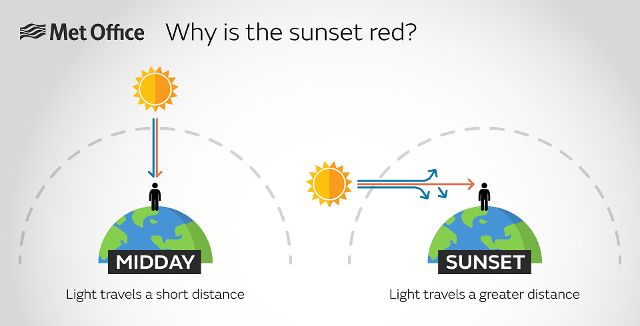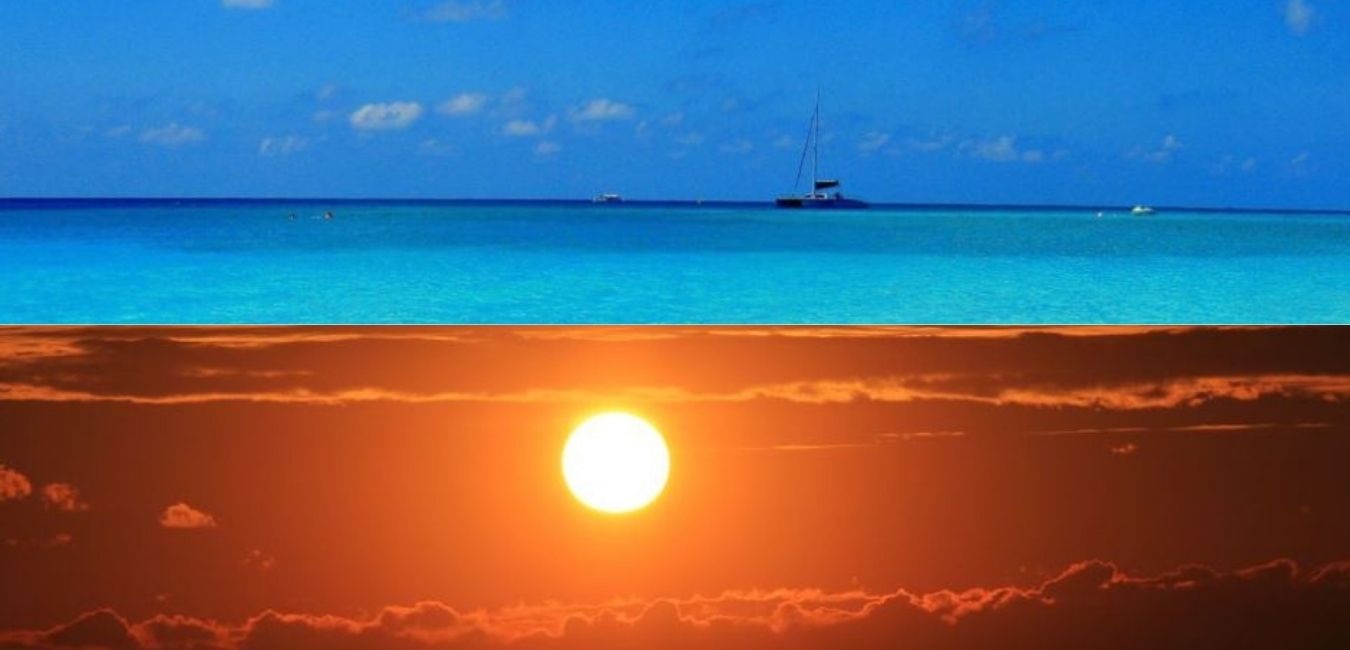Why is the Sky blue? Why is the Ocean blue? Why is Sunset red or orange in colour? Below is a short explanation of that.
As a child, have you ever asked yourself “why the Sky is Blue?”, or better yet “why is the ocean blue?” and why is Sunset red?.
The above query is one of the perennial questions of childhood. You may have asked this as a child, or you may have a child now asking you!.
Interestingly, kids and even adults still wonder why the ocean is blue in color whereas the sunset is red in color. Below are some short answers to the above questions asked by both kids and adults.

Why is the Sky blue?
1. The reflection of the Sun rays.
The explanation begins with the ultimate source of light in our solar system: the Sun. Sunlight appears white, but this white light is made up of all the colors of the visible spectrum, ranging from red through violet. On its path through the atmosphere, sunlight is absorbed, reflected, and altered by different elements, compounds, and particles. The color of the sky depends largely upon the wavelengths of the incoming light, but air molecules (mostly nitrogen and oxygen) and dust particles also play important roles.
When the sun is high overhead, the bulk of its rays intercepts the atmosphere at nearly vertical angles. Shorter wavelengths of light, such as violet and blue, are more easily absorbed by air molecules than light from longer wavelengths (that is, from red, orange, and yellow bands in the spectrum). Air molecules then radiate violet and blue light in different directions, saturating the sky. However, the midday sky appears blue, rather than a combination of blue and violet, because our eyes are more sensitive to blue light than to violet light.
When the sun is near the horizon at dawn and dusk, the sun’s rays strike the atmosphere at more oblique (slanted) angles, and thus these rays must travel a greater distance through the atmosphere than they would at midday. As a result, there are more nitrogen and oxygen molecules and other particles that can block and scatter incoming sunlight.
During this long passage, incoming radiation in the shorter blue and violet wavelengths is mostly filtered out, and the influence of these wavelengths over the color of the sky diminishes. What remains are the longer wavelengths, and some of these rays strike dust and other particles near the horizon, as well as the water droplets that makeup clouds, to create the red, orange, and yellow tints we enjoy at sunrise and sunset.
2. Why the sky is blue: Raleigh scattering phenomenon
The sky is blue due to a phenomenon called Raleigh scattering. This scattering refers to the scattering of electromagnetic radiation (of which light is a form) by particles of a much smaller wavelength. Sunlight is scattered by the particles of the atmosphere, and what comes through down to earth is called diffuse sky radiation, and though only about 1/3rd of light is scattered, the smallest wavelengths of light tend to scatter easier.
These shorter wavelengths correspond to blue hues, hence why when we look at the sky, we see it as blue. At sunset and sunrise, the angle at which sunlight enters the atmosphere is significantly changed, and most of the blue and green (shorter) wavelengths of light are scattered even before reaching the lower atmosphere, so we see more of the orange and red colors in the sky.

Why is the ocean blue?
3. The ocean is blue in colour due to the reflection of the sky.
The ocean is not blue because it reflects the sky, though I believed that up until a few years ago. Water actually appears blue due to its absorption of red light. When light hits the water, the water’s molecules absorb some of the photons from the light. Everything absorbs at a different wavelength (Your green t-shirt absorbs red), and as a result, reflects the remaining colors back at a viewer (that’s why your t-shirt looks green).
In shallow bodies of water (like a drinking glass) light penetrates it completely, as there is not enough water to absorb enough photons, so we see the water as colorless. In deeper waters, however, not all the wavelengths of light can fully penetrate the liquid, as there are too many water molecules in the way of the photons. The water molecules absorb all the red wavelengths from the light, making it reflect blue. This is also why shallower waters appear ‘less’ or lighter blue than deeper ones- less absorption means less reflection.

Why is the sunset red or orange?
Sunsets and sunrises can be some of the most beautiful natural spectacles, but what makes the sky turn different colours during these times?
To begin, we need to understand how we see colour. Light travels from the Sun and through the atmosphere in invisible waves. The light that looks white to us, is actually made up of many different colours of differing wavelengths. For example, blue has a short wavelength, while red is created by longer wavelengths.
4. Why is the sunset red or orange: due to the cause of Rayleigh Scattering effects
At sunrise and sunset, the Sun is very low in the sky, which means that the sunlight we see has traveled through a much thicker amount of atmosphere. Because blue light is scattered more strongly by the atmosphere, it tends to be scattered several times and deflected away in other directions before it gets to us. This means that there is relatively more yellow and red light left for us to see.
The diagram below shows that at midday, light has less atmosphere to travel through. Reaching Earth’s atmosphere, it is scattered in all directions, therefore we see blue sunlight. Blue is scattered more than other colours because it travels as shorter, smaller waves. However, at sunset, light has further to travel through the atmosphere. The shorter wavelength blue light is scattered further, as the sunlight passes over a greater distance, and we see the longer wavelength yellow and red light. These effects are a cause of Rayleigh Scattering.








